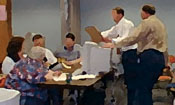

Introduction Table of Contents
- Chapter One - Sources: Whose Idea?
- Chapter Two - The Premises and Assumptions
- Chapter Three - The Politics
- Chapter Four - Powerful Educational Ideas
- Chapter Five - The Perils
- Chapter Six - The Premises and Assumptions
- Chapter Seven - Appraisal: Assessing Organizational Readiness
- Chapter Eight - Clarifying the Destination: Goal Setting and Role-Clarification
- Chapter Nine - Recruitment: Identifying a Positive Campus Council
- Chapter Ten - Rehearsal: Learning and Practicing Group Problem-Solving, Negotiating, Planning and Consulting Skills
- Chapter Eleven - Focus: Concentrating on Essential Issues and Questions
- Chapter Twelve - Research: Discovering What Works
- Chapter Thirteen - Invention: Adapting and Innovating to Match the School Site Context and Reality
- Chapter Fourteen - Inclusion: Hearing and Honoring Constituent Voices
- Chapter Fifteen - Strategy: Converting Intention into Action
- Chapter Sixteen - Skill-Building: Learning Focus, Research, Invention, Inclusion and Strategy
- Chapter Seventeen - The Crow's Nest: Keeping an Eye on the Horizon
- Chapter Eighteen - Islands in the Storm: Assessing and Shifting Course
- Chapter Nineteen - Authentic Assessment and Formative Program Evaluation
- Chapter Twenty - Weathering the Storms: Reefing the Main and Managing Disappointment
- Chapter Twenty-One - Sharing the Load: Involving the Partners
- Chapter Twenty-Two - Celebrating Small Triumphs
- Chapter Twenty-Three - Tacking Across the Wind
- Chapter Twenty-Four - Final Destinations
- Appendix A - School Commitment to Teaching for Thinking
- Appendix B - Planning for the Perils
- Appendix C - The Teacher Adaptability Quotient Scale
- Appendix D - Diagnosis of Team Building Needs
- Appendix E - The Innovation and Environmental Scanning Index
- Notes
Copyrighted 1991 by Jamie McKenzie, all rights reserved.